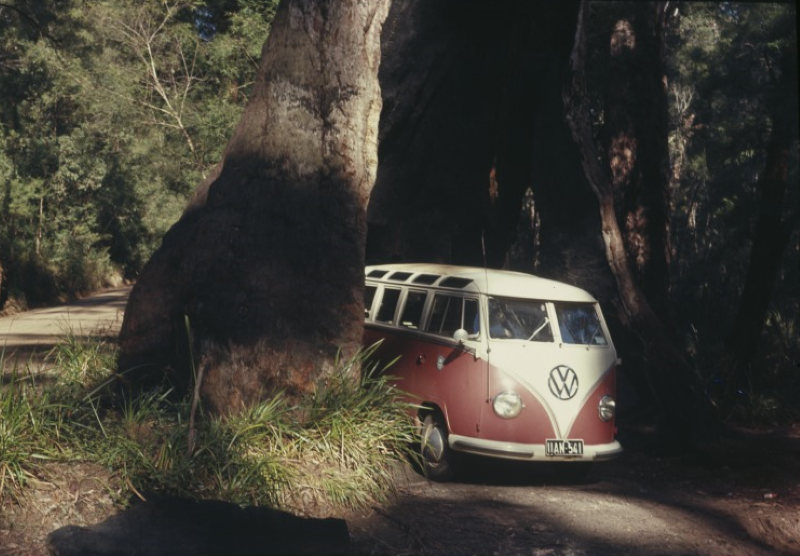Key points
- Australia’s tallest tree is a Mountain Ash in Tasmania.
- Our biggest tree measures over 30 metres in circumference.
- Declaring the oldest tree in the world is difficult, but it could be millions of years old.
Every state and territory in Australia has got big things. Consider the big Merino ram, big chooks, big Ned Kelly, or even the big golden guitar.
We also have big extinct megafauna, like the Diprotodon, a giant marsupial related to the wombat. But we've room in our hearts for Australia's biggest trees.
California can keep the world’s tallest tree, because the 100m-tall Centurion Tree calls Tasmania home. It gives real meaning to the second part of its scientific name, Eucalyptus regnans, which means “ruling”.
The Centurion Tree was the 100th tree Forestry Tasmania discovered using LiDAR. (A remote sensing technology using a laser to create a 3D map of its surrounding.) The Centurion Tree is named in honour of this milestone. As a bonus, its name also references its height.
Unfortunately, our noble Centurion misses out on the gold medal for the tallest tree worldwide. However, we have a strong contender in the eucalyptus. Australia holds records for the world’s tallest eucalyptus, the world’s tallest flowering plant, and the world’s tallest hardwood tree.
The Mountain Ash is among roughly 1000 native Australian eucalypts, and it's remarkable in many other ways. Mountain Ash only release their seeds following bushfire, grow quickly, and provide shelter for the endangered Leadbeater’s Possum.
A 2009 paper by Keith et al., published in Proceedings of the National Academy of Sciences (PNAS), also found that Mountain Ash forests store vast amounts of carbon.
I like big buttressed bases
It’s not the tallest tree in the forest, but the Temple Fig is the biggest. This giant White Fig (Ficus virens) plants its roots in Murwillumbah, New South Wales.
At only 36 metres tall, it’s knee-high to the Centurion. However, this colossus boasts a 30.7m circumference.
White Figs have the dubious honour of being among the ‘strangler figs’, germinating in the crevices of other trees. With their roots growing downwards and the tree stretching ever upwards, Strangler Figs eventually kill their tree hosts.
In WA's Walpole-Nornalup National Park, the 400-year-old Giant Tingle gives the Temple Fig a close run. Their contender eucalypt is an ancient Red Tingle (Eucalyptus jacksonii). At only 30m tall, Giant Tingle doesn't win ribbons for height, but its circumference is a boastful 22.3m. The difference is about the arm span of five humans.
Giant Tingle's bountiful base has been hollowed out by fire but its outer trunk still survives. Visitors to Walpole’s Valley of the Giants Tree Top Walk can stroll underneath and through the tree.
This eucalypt species is known for its beautiful, buttressed base and large, fluted roots. These surprisingly shallow roots stabilise the tree and help it grow in shallow soils over solid granite bedrock.
While the Red Tingle's population is officially stable, it’s severely fragmented and near-threatened. Outside of its national park home, the trees grow in shrinking and isolated sites around the town of Denmark.

Trees as old as Methuselah
When naming the oldest tree in the world, it's difficult to see the forest for the trees. What defines a tree varies. For starters, do you include clonal trees or only individuals?
If you include only individual trees, California’s 4855-year-old Methuselah (a Great Basin Bristlecone Pine) is possibly the oldest.
This Pinus longaeva’s precise age is uncertain, and devotees of a yew tree in Scotland challenge its claim. The Fortingall Yew’s admirers, including Forestry and Land Scotland, estimate their tree is older than Methuselah: around 5000 years old.
But yew trees are notoriously difficult to age accurately. This is because the inner, oldest part of the tree decays as the tree grows. Carbon dating is as tricky as counting the tree’s rings, so we can’t know its exact age.
Then there are clonal trees, referring to groups of organisms with identical DNA. Some trees form clonal colonies, reproducing from suckers connected by a shared root system.
The above-ground trunks of clonal trees aren’t individual trees themselves. Still, we can consider them stems growing from a shared base.
An ancient stand of Huon Pine (Lagarostrobus franklinii) spreads over a hectare on the west coast of Tasmania. This coastal clonal colony is believed to be over 10,000 years old. Information provided by the Royal Tasmanian Botanical Gardens explains that ancient, preserved pollen shows it dates it back more than 10,500 years.
No current individual tree in the group is that age. However, because they are genetically identical male clones of the original, they’re considered the same plant.
But that’s still not the oldest.
The Wollemi Pine (Wollemia nobilis) was considered extinct for the last 60 million years until a chance discovery in NSW back in 1994.
In a preprint article made available by bioRxiv, an article by Stevenson et al., calls the Wollemi "a critically endangered 'living fossil' unchanged since the Cretaceous". It suggests the tree could have originated from a small group of individuals and may have been cloning itself for millions of years.
There's good news for the extraordinary tree. The Wollemi was made available to home gardeners in Australia, and around the world, in 2005. This was following huge public interest and as part of efforts protecting wild populations.
In research published last year, scientists from our National Research Collections of Australia investigated Wollemi Pines. Specifically, they wanted to know how they've thrived in home garden settings. What they discover might hold the secrets to more successful conservation plantings.
We're unsure exactly how old this critically endangered dinosaur tree is. Fortunately, careful study and passionate gardeners worldwide are helping preserve this piece of our planet's past for future generations.
